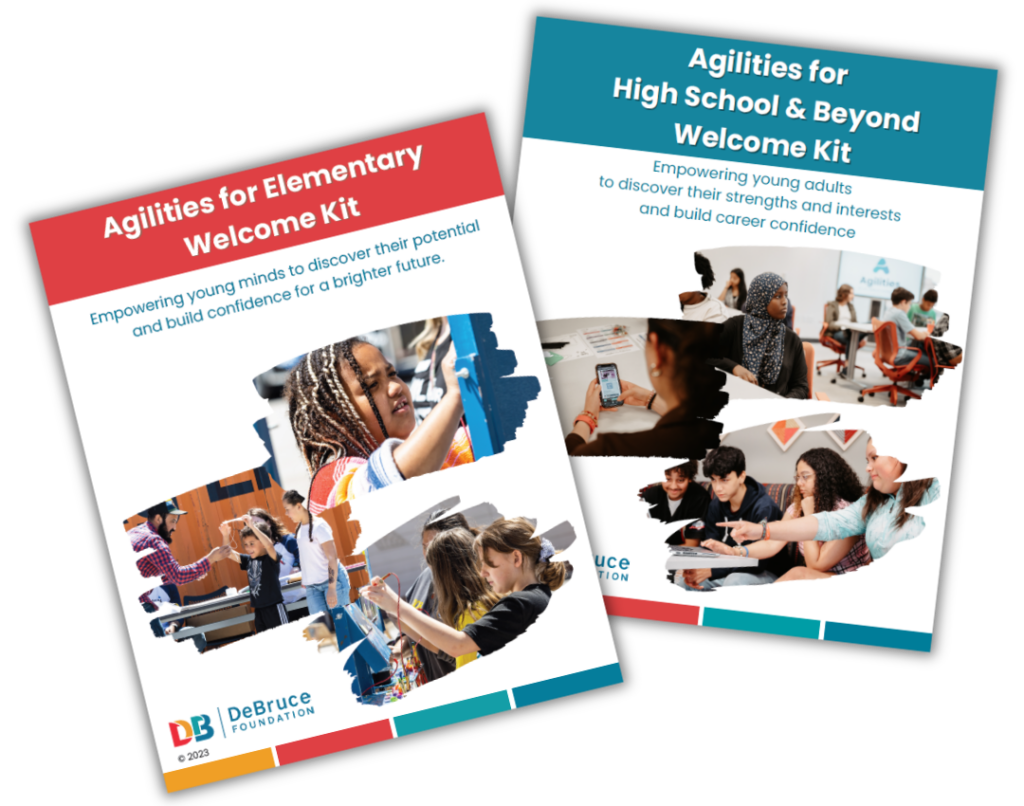Link copied to clipboard
New Agilities Resources for Your Classroom
A special back-to-school post for educators
By Rebecca Kessler, Education and Integration Specialist at The DeBruce Foundation
Don’t you love the smell of fresh crayons and pencils at the start of the year? All the possibilities for students to grow and learn are just starting to develop. No matter what grade level you teach, you are going to make a difference this year by building those relationships and sharing your passion for your content. I’ve worked in the classroom with first-grade to post-graduate students. My favorite moments with my students have always been related to seeing the magic “light bulbs” come on, where they finally discover they can do something, understand something, or learn something!
Students of all ages deserve to feel confident about their skills, interests, and future plans. At The DeBruce Foundation, we’ve identified work skills that are used in every job throughout the workforce. These work skills, which we call Agilities, can be learned, practiced, and cultivated over time. The Agilities of work are as follows:
- Developing Others – the Agility for recognizing and cultivating others’ talents
- Innovating – the Agility for thinking outside the box
- Inspecting – the Agility for monitoring compliance with rules and standards
- Judging and Estimating – the Agility for having sound judgment and critical thinking
- Managing – the Agility for supervising people and situations to achieve positive outcomes
- Operating Objects – the Agility for working with machines, tools, and devices
- Organizing – the Agility for creating and maintaining order in work tasks
- Selling and Communicating – the Agility for influencing and persuading others
- Serving and Caring – the Agility for developing strong social relationships and helping others with their needs
- Working with Information – the Agility for working with information technology, management, and processing
Learning about the Agilities is a great foundation for students of any age. By building awareness and developing Agilities early, you help students build confidence in their abilities and set the foundation for future success. To assist you in helping to develop students’ self-concepts, we’ve developed two new Agilities© resources: Agilities for Elementary Welcome Kit and Agilities for High School and Beyond Welcome Kit.

For our youngest learners, we’ve selected to focus on providing experiences for all the Agilities, developing the language to empower your students, and developing an Agility-Centered Classroom! Help students explore how they can grow and develop their Agilities at school, at home, and in the community. Developing the Agilities at a younger age sets the foundation for students to see their value in the world and how that value can lead to their career path in later life.
For our older learners and young adults, we’ve selected to focus on building students’ capacity for sharing their Agilities with others. Students learn ways to share their Agilities in their resumes, cover letters, and interviews. Developing an Agility Classroom is valuable to creating a culture that shares experiences with others and brings in community members to help share experiences with your students. Students also learn to differentiate between the Agilities and how they present themselves in their everyday lives.
We also have a resource that brings caregivers in partnership with helping their child grow and develop the Agilities. Pairing this “Just Play” resource with either the “Learning Your Agilities” or “Leveraging Your Agilities” one-page sheets is a great way to work together to develop each student’s strengths and interests.

Providing students with the skills to see their value, develop them over time, and communicate it with the world will set the course to change their lives. There’s a quote that states, “A teacher affects eternity; he can never tell where his influence stops.” By enriching the learning environment with the Agilities, you pave the way for students to gain access to scholarships, grants, interviews, and income that will change their family legacies. Planting the seeds with students to nurture as they grow will have a lasting effect on their lives that you’ll likely never see, but know that it’s worth it to have your hand on a piece of the future.

